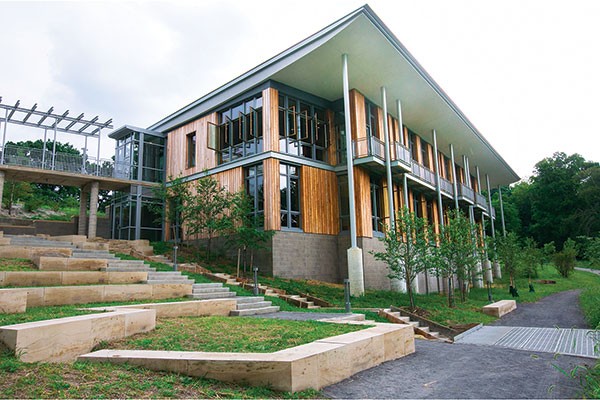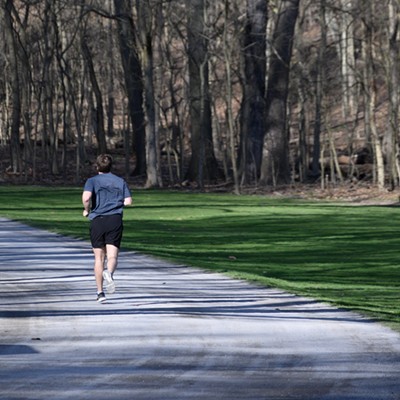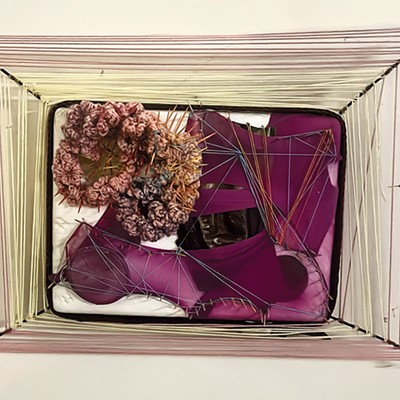The new Frick Environmental Center hits all the marks
It’s a public building and classroom that makes all its own energy

The new Frick Environmental Center, off Beechwood Avenue in Squirrel Hill
As you approach the new Frick Environmental Center from its historic entry gatehouses on Beechwood Boulevard, in Squirrel Hill, three paths lead to the fountain about 100 yards away that is part of that original landscape. One curves to your left, past the parking lots, where solar arrays generate power for the building and guide rainwater into catchment basins for reuse. Another path goes straight to the historic fountain, which is re-engineered to use just a mist of water rather than the traditional but wasteful vertical spout. The third path curves to the right, past the outdoor amphitheater and into the building itself, a 15,500-square-foot structure, designed by BCJ Architects and built by contractors P.J. Dick.
The $19 million building and landscape project is owned by the city and operated by the Pittsburgh Parks Conservancy, primarily as education and support spaces for school groups and the public. Having three linked but different paths, each with its own lessons, is emblematic of the building as a whole, which can be considered highly successful from a number of seemingly separate but ultimately unified perspectives.
You could simply praise this as a handsome building. Pittsburgh’s apartment and condo markets have had some real clunkers of late. Likewise, when it comes to environmentally conscientious design, some architects are satisfied with blandness or worse, with only green virtues as a prevailing goal. But this structure sits on its sloping site that opens visually downhill to the south, and a roof that tilts up and out ever so slightly, covering projecting balconies. It’s less a derivation of Frank Lloyd Wright and more an embodiment of some similar commonsense priorities of passive solar orientation.
The brand identity of (firm-leading) architect Peter Bohlin’s elegantly detailed design sensibility, with origins in American Northwestern woodlands, is recognizable and very suitable here. The slightly syncopated rhythm of the columns and windows, as well as the exterior walls enclosed with unfinished black locust, are just enough to create a poetic relationship with the surrounding woods while feeling tasteful rather than hokey. Meanwhile, the outdoor amphitheater and water sculpture, by artist Stacy Levy, connect to the greater park, as does its articulation of the building as a part of the continuous path, rather than just an object on its own. “The building is really just an entrance to the park,” says Matt Plecity, who was an architect at BCJ on the building’s early design.
The building is independently significant as an achievement in sustainable architecture. The claim that it’s “the greenest public building in the world” could seem numbing. Didn’t we just do something like this at the Phipps Conservatory? We did, but both structures are remarkable. The Living Building Challenge is an independently operated certification program that documents a structure’s ability to produce all the energy it uses, and to use rainwater captured onsite (although the drinking water comes from the municipal system). So for the Frick Environmental Center, five ground-source heat pumps, drilled 525 feet into the ground, provide heating and cooling for the building, with 152 kilowatts of power supplied by solar arrays over the parking lot. It will take several months of testing to certify the building’s performance. Certification is not automatic. But this would be only the 11th building globally to meet the Living Building standard.
The building is also anticipated to achieve LEED Platinum status — though LEED certification is notably less rigorous than the Living Building Challenge, according to P.J. Dick’s Noah Shaltes.
You could likewise simply praise this building for its function as an outreach to school students and programs. The From Slavery to Freedom garden, at the entry to the park, makes traditional cultivation practices of African Americans an intrinsic part of the park experience, diversifying the appeal of a public facility named for its wealthy white donor. Features such as the rain veil, where water falls like a curtain from the building eaves, emphasize the rain-or-shine appeal. Education Director Camilla Rivera Tinsley explains that more schools are participating in programs, and more are making repeat visits for more involved programs.
From a building that encourages connections to the adjacent park and to principles of nature more broadly, we would do well by continuing to ask the questions that it raises. Are forthcoming buildings making net-zero energy use part of their goals? Why or why not? What about other enterprises, such as maybe driverless cars? The paths to better environmental stewardship begin very effectively at Frick Park. We should follow the example of this new building (and landscape) and continue such priorities beyond the gates, not just within them.
The $19 million building and landscape project is owned by the city and operated by the Pittsburgh Parks Conservancy, primarily as education and support spaces for school groups and the public. Having three linked but different paths, each with its own lessons, is emblematic of the building as a whole, which can be considered highly successful from a number of seemingly separate but ultimately unified perspectives.
You could simply praise this as a handsome building. Pittsburgh’s apartment and condo markets have had some real clunkers of late. Likewise, when it comes to environmentally conscientious design, some architects are satisfied with blandness or worse, with only green virtues as a prevailing goal. But this structure sits on its sloping site that opens visually downhill to the south, and a roof that tilts up and out ever so slightly, covering projecting balconies. It’s less a derivation of Frank Lloyd Wright and more an embodiment of some similar commonsense priorities of passive solar orientation.
The brand identity of (firm-leading) architect Peter Bohlin’s elegantly detailed design sensibility, with origins in American Northwestern woodlands, is recognizable and very suitable here. The slightly syncopated rhythm of the columns and windows, as well as the exterior walls enclosed with unfinished black locust, are just enough to create a poetic relationship with the surrounding woods while feeling tasteful rather than hokey. Meanwhile, the outdoor amphitheater and water sculpture, by artist Stacy Levy, connect to the greater park, as does its articulation of the building as a part of the continuous path, rather than just an object on its own. “The building is really just an entrance to the park,” says Matt Plecity, who was an architect at BCJ on the building’s early design.
The building is independently significant as an achievement in sustainable architecture. The claim that it’s “the greenest public building in the world” could seem numbing. Didn’t we just do something like this at the Phipps Conservatory? We did, but both structures are remarkable. The Living Building Challenge is an independently operated certification program that documents a structure’s ability to produce all the energy it uses, and to use rainwater captured onsite (although the drinking water comes from the municipal system). So for the Frick Environmental Center, five ground-source heat pumps, drilled 525 feet into the ground, provide heating and cooling for the building, with 152 kilowatts of power supplied by solar arrays over the parking lot. It will take several months of testing to certify the building’s performance. Certification is not automatic. But this would be only the 11th building globally to meet the Living Building standard.
The building is also anticipated to achieve LEED Platinum status — though LEED certification is notably less rigorous than the Living Building Challenge, according to P.J. Dick’s Noah Shaltes.
You could likewise simply praise this building for its function as an outreach to school students and programs. The From Slavery to Freedom garden, at the entry to the park, makes traditional cultivation practices of African Americans an intrinsic part of the park experience, diversifying the appeal of a public facility named for its wealthy white donor. Features such as the rain veil, where water falls like a curtain from the building eaves, emphasize the rain-or-shine appeal. Education Director Camilla Rivera Tinsley explains that more schools are participating in programs, and more are making repeat visits for more involved programs.
From a building that encourages connections to the adjacent park and to principles of nature more broadly, we would do well by continuing to ask the questions that it raises. Are forthcoming buildings making net-zero energy use part of their goals? Why or why not? What about other enterprises, such as maybe driverless cars? The paths to better environmental stewardship begin very effectively at Frick Park. We should follow the example of this new building (and landscape) and continue such priorities beyond the gates, not just within them.


















